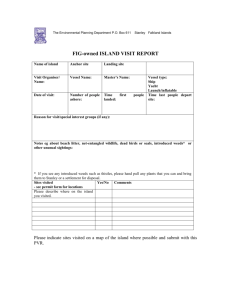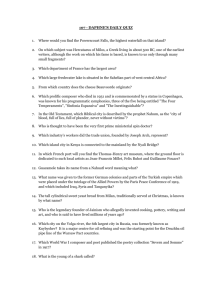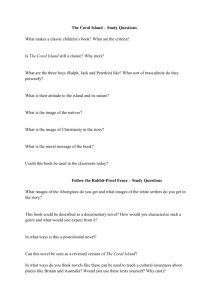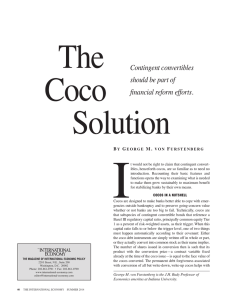Guam Department of Agriculture, Division of Aquatic & Wildlife
advertisement
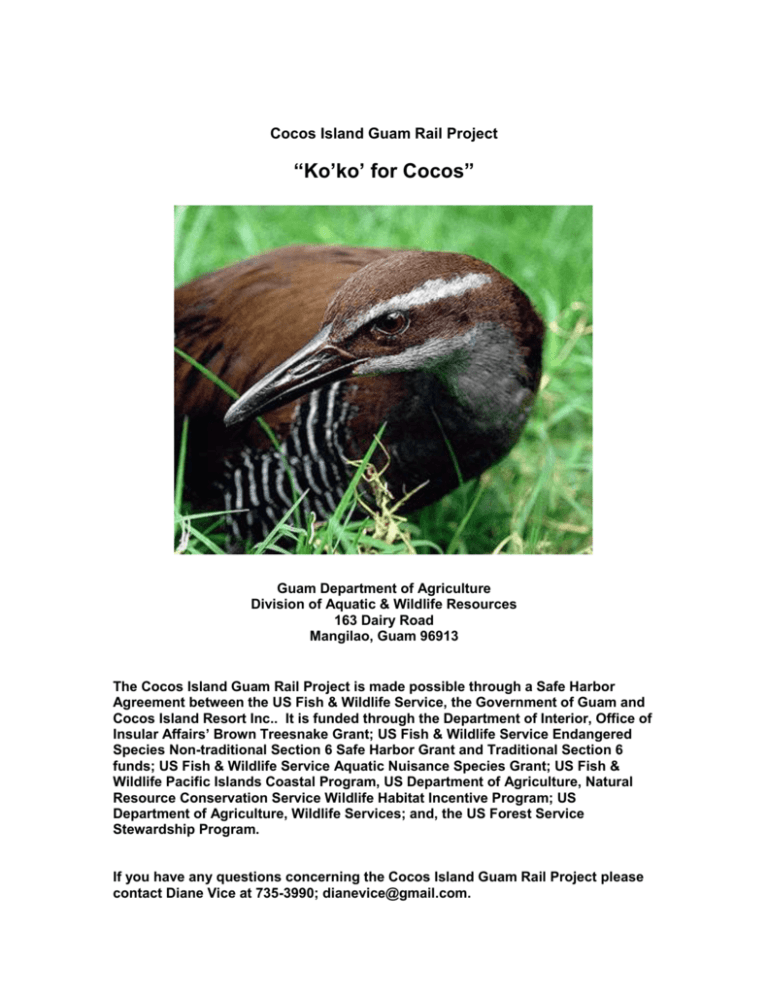
Cocos Island Guam Rail Project “Ko’ko’ for Cocos” Guam Department of Agriculture Division of Aquatic & Wildlife Resources 163 Dairy Road Mangilao, Guam 96913 The Cocos Island Guam Rail Project is made possible through a Safe Harbor Agreement between the US Fish & Wildlife Service, the Government of Guam and Cocos Island Resort Inc.. It is funded through the Department of Interior, Office of Insular Affairs’ Brown Treesnake Grant; US Fish & Wildlife Service Endangered Species Non-traditional Section 6 Safe Harbor Grant and Traditional Section 6 funds; US Fish & Wildlife Service Aquatic Nuisance Species Grant; US Fish & Wildlife Pacific Islands Coastal Program, US Department of Agriculture, Natural Resource Conservation Service Wildlife Habitat Incentive Program; US Department of Agriculture, Wildlife Services; and, the US Forest Service Stewardship Program. If you have any questions concerning the Cocos Island Guam Rail Project please contact Diane Vice at 735-3990; dianevice@gmail.com. Cocos Island Guam Rail Project “Ko’ko’ for Cocos” Introduction The Guam rail, known as ko’ko’ in Chamorro, is a flightless bird that was found only on Guam. In the late 1960s and early 1970s, the population of ko’ko’ on Guam was estimated between 60,000 to 80,000. Ko’ko’ were often seen during early morning and late evening foraging and bathing along field edges and roadsides. By the mid 1980s the ko’ko’ and other forest bird populations on Guam were devastated by the brown treesnake. With the help from mainland zoos, Guam Division of Aquatic and Wildlife Resources (DAWR) collected 19 ko’ko’ from the wild. These original captured ko’ko’ were used to develop a captive breeding program for reintroductions. Today there is a captive flock at DAWR’s breeding facility in Mangilao, as well as another captive population in US mainland zoos. Attempts to establish ko’ko’ in snake-reduced areas on Guam have had limited success. Although the ko’ko’ are able to reproduce in the presence of low snake densities, they cannot withstand the presence of feral cats in an environment where deer and pig eat and trample all the vegetation. Cocos Island can provide an excellent site for ko’ko’ reintroductions; it is cat, deer and pig free. Few snakes have been reported on Cocos Island; there may be a small population or none. Free-ranging ko’ko’ on Cocos Island will create an opportunity for Guam residents and visitors to see the endangered bird. The following are the steps necessary to establish ko’ko’ on Cocos Island. 1. Prevent the transport of unwanted pests to Cocos Island. Bio-security is a term used to describe activities that prevent the introduction of unwanted species into an area. The resort vendors, as well as vessels using the public dock on Cocos, will need to take small precautions to prevent invasion (and reinvasion) of pests. The precautions will be implemented prior to the removal of rats and mice from Cocos Island (in consultation with the resort and the public). A public information campaign will be a key component in garnering support for the new procedures. 2. Eradicate rats and mice on Cocos Island. US Department of Agriculture, Wildlife Services will be contracted to remove the rats and mice from Cocos Island once the biosecurity procedures are in place. Wildlife Services will design a plan to target all rats and mice while minimizing impacts to the operation of the resort, public safety and the island’s wildlife. Public meetings will be held to address public concerns. Cocos Island Guam Rail Project 1 3. Reduce impacts of monitor lizards on newly released ko’ko’. Monitor lizards may eat newly released ko’ko’, rail nests (eggs or chicks), and nesting birds. To minimize the amount of ko’ko’ killed by monitor lizards, DAWR will reduce the monitor lizard population on Cocos Island. 4. Detect brown treesnakes (if present). Following the removal of rats and mice from Cocos Island, a combination of snake control tools will be used to determine if there is a population of brown treesnakes on Cocos Island. Brown treesnake detector dogs, bait stations and traps will be used. If no snakes are detected, monitoring using bait stations and/or snake traps will continue. If a snake is detected, the goal of the brown treesnake work on Cocos Island will switch to eradication. The release of ko’ko’ is not dependant on the removal of all brown treesnakes, as ko’ko’ can reproduce in the presence of a few snakes; however, best efforts will be taken to remove all snakes prior to the release of the birds. 6. Establish Guam rails on Cocos Island. Sixteen captive-bred ko’ko’ will be released on Cocos Island. The released birds will have radio transmitters and will be monitored to determine how long they live, where they live and how many chicks they produce. 7. Improve native forest on Cocos Island. The ko’ko’ requires vegetation that provides cover for their secretive nature, yet not so thick that it prevents movement. Cocos Island’s native forest will be improved by removing invasive vine, ground cover and tree species. As well, native plant species that are better suited to withstand typhoon conditions will be transplanted. In the resort area vegetative cover may be improved by replacing cultivated varieties with native species (in consultation with Cocos Island Resort). 8. Establish a fun promotional campaign that focuses on the Cocos Island ko’ko’ as a public treasure to be protected. Keeping Cocos Island pest-free will be a challenge. Public support will be a key component in the success of the project. A brochure describing the project will be developed to promote the ko’ko’ on Cocos Island. Stickers, magnets, t-shirts, banners and special events will focus on the ko’ko’ and encourage individuals or groups to visit Cocos Island. Information will be posted at the pier area in Malesso’, Cocos Island Resort, and the government park. In addition to quarantine issues, the signs will provide information about Guam’s endangered ko’ko’, the causes of decline and efforts underway for their recovery. Cocos Island Guam Rail Project 2


